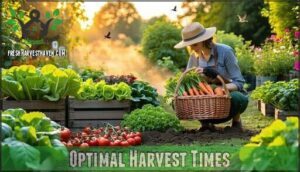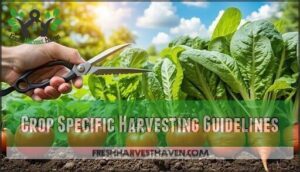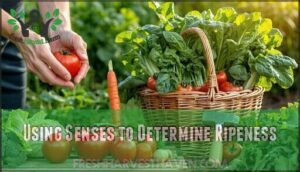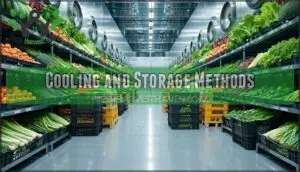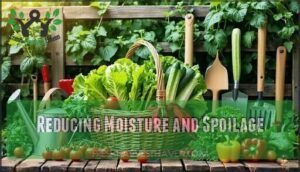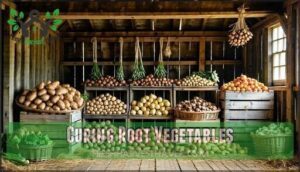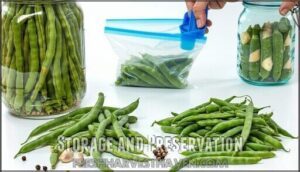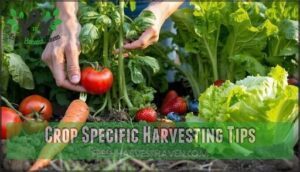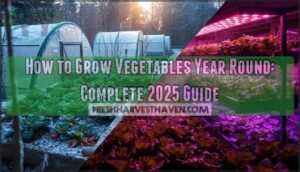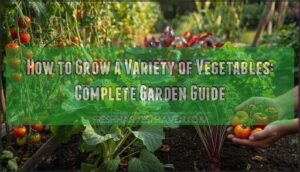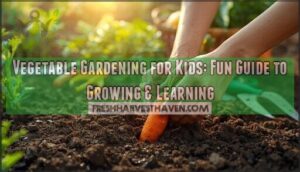This site is supported by our readers. We may earn a commission, at no cost to you, if you purchase through links.
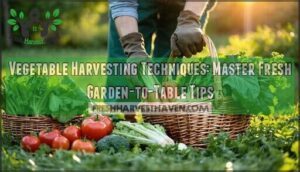
You’ll know vegetables are ready when they show vibrant color, firm texture, and proper size for their variety.
Use clean, sharp tools to cut stems rather than pulling, which can damage root systems.
Different crops have unique signals: tomatoes yield slightly to gentle pressure, carrots lift easily from soil, and leafy greens snap crisply.
Handle your harvest gently – bruised vegetables spoil faster than a forgotten lunch in summer heat.
Proper timing transforms good gardeners into harvest wizards who maximize both flavor and storage life.
Table Of Contents
- Key Takeaways
- Harvesting Methods Overview
- Harvest Timing and Techniques
- Post Harvest Handling
- Storage and Preservation
- Crop Specific Harvesting Tips
- Frequently Asked Questions (FAQs)
- What is the most commonly practiced method of harvesting vegetables?
- Which vegetables should not be planted next to each other?
- How do you harvest vegetables properly?
- What are the three methods of harvesting?
- How to prevent pest damage during harvesting?
- What weather conditions should delay harvesting?
- How to sanitize harvesting tools properly?
- When should you replace harvesting equipment?
- How to harvest from diseased plants safely?
- Conclusion
Key Takeaways
- Time your harvests during cool morning hours when plants hold maximum moisture, and you’ll capture peak flavor and nutritional value.
- Use clean, sharp tools to cut stems rather than pulling, which prevents root system damage and disease spread between plants.
- Learn each crop’s unique ripeness signals: tomatoes yield to gentle pressure, carrots lift easily from soil, and leafy greens snap crisply when ready.
- Handle harvested vegetables gently and store them immediately in proper temperature and humidity conditions to extend shelf life by 40-60%.
Harvesting Methods Overview
Your harvesting method depends on your crop type, available resources, and desired efficiency.
You’ll choose between hand harvesting for delicate produce like strawberries, using hand tools for tree fruits and precision crops, or employing machinery for large-scale operations and grain harvests.
Hand Harvesting Techniques
When mastering hand harvesting methods, you’ll discover that gentle handling transforms your garden’s potential into kitchen-ready perfection.
Transform your harvest into kitchen perfection through gentle handling techniques.
This labor-efficient approach requires no specialized harvesting tools—just your hands and proper containers for crop selection.
- Hand picking strawberries and delicate leafy greens prevents bruising
- Gentle picking techniques maintain produce quality during harvest
- Labor efficiency improves with practice and systematic approaches
Hand harvesting excels for fragile crops where leafy greens harvesting techniques demand careful attention to preserve tender leaves and stems.
Effective harvesting also involves using the right hand harvesting tools to make the process easier.
Harvesting With Hand Tools
When hand harvesting isn’t enough, you’ll reach for specialized tools that boost harvest efficiency while maintaining gentle picking standards.
Sharp clippers and pruning shears become your precision instruments for tree fruits and delicate crops.
| Tool Type | Best For | Safety Tip |
|---|---|---|
| Pruning Shears | Tree fruits, thick stems | Keep blades sharp for clean cuts |
| Harvest Knife | Leafy greens, herbs | Use cutting motion away from body |
| Garden Scissors | Delicate vegetables | Clean between plants to prevent disease |
| Picking Bags | Hands-free collection | Secure straps to prevent spills |
| Harvest Baskets | Root vegetables | Line with cloth for crop handling |
Proper tool maintenance prevents plant damage and helps labor practices remain efficient throughout your harvesting methods.
Effective harvest planning strategies are vital for maximizing yield and minimizing waste.
Harvesting With Machinery
Mechanical harvesting transforms large-scale operations through advanced farm equipment.
Modern automation systems monitor crop conditions while specialized machinery handles volume processing efficiently.
- Harvest rigs combine picking, washing, and packing functions for streamlined field operations
- Harvesting mowing machines cut leafy crops like spring mix and basil with precision timing
- Combines process grain crops through integrated threshing, cleaning, and collection systems
These machinery types reduce labor dependency while maintaining quality standards through crop monitoring technology.
Harvest Timing and Techniques
Knowing when to harvest your crops makes the difference between bitter disappointment and sweet success in your garden.
You’ll master the art of timing by combining visual cues, sensory tests, and plant-specific knowledge to capture vegetables at their peak flavor and nutritional value.
Optimal Harvest Times
Timing your harvest correctly separates amateur gardeners from pros who maximize flavor and nutrition.
Monitor ripening signs daily once crops begin producing—color changes, texture shifts, and aromatic development signal readiness.
Implement harvest schedules based on crop monitoring rather than calendar dates alone.
Fruit quality peaks during specific ripening stages, making timing strategies your most valuable tool for harvest timing optimization during prime harvest periods.
Crop Specific Harvesting Guidelines
Each crop demands unique attention—leafy greens like spinach require cutting outer leaves at four inches, while fruiting vegetables such as tomatoes need color assessment for peak ripeness.
Root crops including carrots harvest best at one-inch diameter.
Understanding these crop specific harvesting guidelines guarantees maximum crop yields through proper harvest timing and vegetable harvesting techniques.
For the best results, consult a vegetable harvest guide to determine the ideal harvest time for each crop, ensuring you achieve the best possible outcome with proper harvest timing.
Using Senses to Determine Ripeness
Beyond looking at maturity date guidance, your senses become powerful ripeness indicators for perfect harvests.
Sensory evaluation through multiple techniques guarantees flawless flavor development across different ripening stages.
- Smell Test & Color Check: Fresh aromas and vibrant hues signal peak readiness
- Touch Method & Sound Technique: Gentle pressure and hollow sounds reveal internal maturity
- Taste Test: Sample small portions to confirm sweetness and texture development
Post Harvest Handling
Once you’ve harvested your vegetables, proper handling in the first few hours determines their shelf life and quality for weeks to come.
Your post-harvest techniques can make the difference between crisp, flavorful produce and wilted disappointments that belong in the compost bin.
Cooling and Storage Methods
Once you’ve harvested your produce, proper cooling systems become your best defense against spoilage.
Forced-air cooling works for most vegetables, while hydrocooling rapidly drops temperatures using cold water sprays.
Storage facilities require precise temperature management and humidity control – leafy greens need 95% humidity at 32°F, while onions prefer drier conditions.
Ventilation systems prevent moisture buildup, ensuring your vegetable storage maintains optimal freshness through controlled cooling and ventilating harvested produce.
Understanding optimal storage conditions is vital for maintaining the quality of your vegetables.
Reducing Moisture and Spoilage
Ventilation works as your garden’s exhale system, moving stagnant air that harbors disease-causing bacteria and molds.
You’ll prevent spoilage by maintaining proper airflow around stored vegetables, keeping humidity levels between 65-95% depending on crop type.
Moisture control becomes your frontline defense against rot, while humidity management systems help regulate storage conditions for maximum freshness preservation.
Curing Root Vegetables
Root cellars aren’t your only storage option—proper curing transforms freshly dug vegetables into long-lasting pantry staples.
You’ll need to dry potatoes, onions, and garlic in well-ventilated areas with controlled humidity before final storage. This vegetable curing process removes excess moisture, preventing rot while concentrating flavors.
Mastering these storage methods by maintaining ideal temperatures and humidity control for extended shelf life is crucial. Understanding root vegetable handling techniques is vital for successful curing and storage.
Storage and Preservation
Once you’ve harvested your fresh vegetables, proper storage becomes critical for maintaining quality and extending shelf life.
Understanding the right temperature and humidity conditions can mean the difference between enjoying your garden produce for weeks versus watching it spoil within days, which is influenced by complete concepts of storage.
Temperature and Humidity Control
For proper vegetable storage, temperature monitoring and moisture management form the foundation of extending freshness.
Climate control requires precision since produce lifespan decreases 25% for every 10°F temperature increase.
Master these storage conditions:
- Cool and dry storage: 50-60°F with 60% relative humidity for potatoes and onions
- Cold and dry storage: 32-40°F with 65% humidity for certain vegetables
- Cold and moist storage: 32-40°F with 95% humidity for leafy greens
- Storage ventilation: Essential air circulation prevents spoilage and maintains ideal conditions
Effective temperature control systems utilize temperature controller technology to maintain preferred storage environments.
Long Term Storage Options
For serious gardeners, Cool Storage options extend beyond basic refrigeration.
Root Cellars provide ideal conditions—33-40°F with 90-95% Humidity Control—keeping potatoes, carrots, and beets fresh for 5-9 months.
Dry Preservation works best for onions and garlic in 65% storage humidity, while Sand layering maintains carrot crispness.
Insulated outbuildings offer budget-friendly longterm storage options with proper ventilation.
Preserving Through Pickling and Freezing
Once you’ve mastered harvesting, pickling and freezing extend your vegetables’ shelf life dramatically.
Pickling methods preserve cucumbers, peppers, and beets in acidic brines, while proper freezing techniques maintain nutritional value for months.
Always use food-safe storage containers and follow established preserving food protocols.
These vegetable preservation methods transform your harvest into year-round pantry staples.
Understanding proper freezing techniques is essential for maintaining the quality of your frozen vegetables.
Crop Specific Harvesting Tips
Each crop has its own sweet spot for harvesting, and knowing these specific cues can transform your garden yield from mediocre to magnificent.
Understanding the unique indicators for leafy greens, fruiting vegetables, root crops, and berries guarantees you’ll capture peak flavor and nutritional value every time.
Leafy Greens and Herbs Harvesting
Mastering leafy greens harvesting transforms your garden into a continuous salad bar.
The "cut and come again" method maximizes yields while maintaining plant health.
Essential leafy green harvesting techniques:
- Harvest timing: Pick early morning after dew dries for ideal herb flavor
- Selective cutting: Remove outer leaves, leaving central growth intact for greens regrowth
- Tool maintenance: Use clean pruners to prevent disease during herb cutting
- Leaf harvesting frequency: Weekly harvests stimulate rapid new growth
- Plant preservation: Leave one-third of foliage for continued photosynthesis and herb picking success
Fruiting Vegetables Harvesting
Tomato harvesting requires patience—leave fruit on the vine until deeply colored and slightly firm for complex flavors.
Cut peppers rather than pulling to avoid plant damage.
Check cucumber care daily, harvesting at 6-10 inches to prevent bitterness.
Squash timing matters; pick zucchini at 6-8 inches for tender texture.
Handle eggplants gently when glossy.
Root Vegetables Harvesting
Why harvest root vegetables when the ground’s still workable? Smart carrot harvesting involves loosening soil first, then gently pulling to avoid breakage. Root vegetables handling requires patience and proper timing for ideal flavor and storage life.
- Carrot harvesting: Dig around roots with fingers before pulling to prevent snapping longer varieties
- Beet storage: Harvest at 2-3 inches diameter, trim tops to ¼ inch, store in cool conditions
- Potato care: Wait until foliage browns, cure for 10 days in dark ventilated areas
- Radish timing: Pull promptly when shoulders appear above soil to avoid pithy texture
- Turnip handling: Best at 2-3 inches diameter using gentle extraction techniques
Harvesting Fruits and Berries
Fruit ripening requires careful observation and precise harvest timing.
Check strawberries daily for deep red color and sweet fragrance, picking every other day for peak freshness.
Cantaloupes slip easily from vines when ripe, while watermelons develop yellow belly spots.
Blueberries should feel plump with uniform color, and practice gentle fruit handling techniques during berry picking to prevent bruising.
Implement proper berry storage methods immediately after harvest.
Frequently Asked Questions (FAQs)
What is the most commonly practiced method of harvesting vegetables?
You’ll typically encounter hand harvesting as the most prevalent method, especially for delicate produce like tomatoes, peppers, and leafy greens that require careful handling to prevent damage and maintain quality.
Which vegetables should not be planted next to each other?
Like planting enemies in a minefield, you’ll create garden chaos by pairing incompatible crops.
Avoid placing onions near beans or asparagus, tomatoes beside corn, and cabbage near nightshades—they compete fiercely for nutrients.
They compete fiercely for nutrients.
How do you harvest vegetables properly?
Morning harvests yield the best results when crops are dry and cool.
Use sharp, clean tools to prevent disease spread.
Pick produce at prime ripeness by checking color, firmness, and aroma rather than size alone.
What are the three methods of harvesting?
Ironically, you’d think harvesting’s complex, but there are just three straightforward methods: hand harvesting without tools, harvesting with hand tools like clippers, and machine harvesting with specialized equipment like combines.
How to prevent pest damage during harvesting?
You’ll protect your harvest by scheduling early morning picks, using sharp sanitized tools, handling produce gently, and storing crops immediately in cool conditions to minimize pest attraction and damage.
What weather conditions should delay harvesting?
Rain, frost, and high winds can damage crops and compromise quality. You shouldn’t harvest when produce is wet from dew or precipitation, as moisture promotes rot and disease during storage.
How to sanitize harvesting tools properly?
Clean your harvesting tools with a 10% bleach solution or 70% rubbing alcohol between crops and plants. Scrub off dirt first, then apply sanitizer and let air-dry completely before use.
When should you replace harvesting equipment?
Like a worn blade losing its bite, your harvesting equipment needs replacement when damage compromises crop quality and safety.
Replace tools showing rust, dull cutting edges, cracked handles, or bent components that can’t be sharpened or repaired effectively, to ensure safety.
How to harvest from diseased plants safely?
Always disinfect tools between diseased and healthy plants.
Harvest affected produce separately, dispose of diseased material properly, and wash hands thoroughly.
Don’t compost infected plant debris—this prevents spreading pathogens throughout your garden, and always remember to handle diseased material with care.
Conclusion
Like a surgeon’s precise scalpel stroke, perfecting vegetable harvesting techniques transforms your garden into a precision operation.
Studies show proper harvesting can extend storage life by 40-60%. You’ve learned to read your crops’ signals, time your harvests perfectly, and handle produce with surgical care.
These methodical approaches guarantee maximum nutrition retention and flavor preservation. Whether you’re cutting herbs at dawn or lifting carrots at sunset, your systematic harvesting techniques will consistently deliver peak-quality vegetables from garden to table, ensuring the best results with maximum nutrition.
- https://arxiv.org/html/2503.22809
- https://hgic.clemson.edu/factsheet/harvesting-vegetables/
- https://www.theproducenerd.com/2019/09/harvesting-methods-fruits-vegetables/
- https://www.numberanalytics.com/blog/ultimate-guide-harvesting-methods-agricultural-mechanization
- https://www.syngentavegetables.com/news/expert-insights/robotic-tomato-harvesting-enables-faster-innovations-research-and-development

